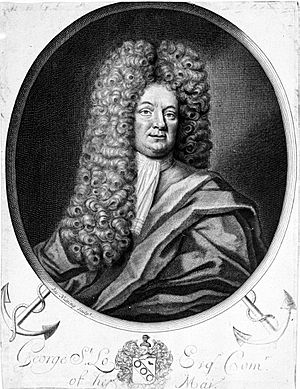George St Lo facts for kids
Quick facts for kids
George St Lo
|
|
|---|---|
 |
|
| Born | 19 April 1655 |
| Died | 20 September 1718 (aged 63) Northfleet, Kent |
| Buried |
Northfleet
|
| Allegiance | Kingdom of Great Britain |
| Service/ |
Royal Navy |
| Years of service | –1718 |
| Rank | Captain |
| Commands held | HMS Dartmouth HMS Portsmouth |
| Battles/wars | |
| Relations | Edward St. Lo (nephew) |
George St Lo (sometimes spelled St Loe; born April 19, 1655 – died September 20, 1718) was a British naval officer and politician. He served in the Royal Navy during important conflicts like the Nine Years' War and the War of the Spanish Succession.
After being injured and captured in battle, his time at sea ended. He then started a career in politics and government. He held positions as a commissioner for the navy and was a Member of Parliament. St Lo was known for his strong opinions on how the navy should be run.
Contents
George St Lo was born on April 19, 1655, in Dorset, England. His family had important connections, including to the Hyde family, which helped him get ahead in the navy. He was even a distant cousin of Queen Mary II and Queen Anne.
St Lo joined the navy and quickly moved up the ranks. By 1678, he was a lieutenant serving in the Mediterranean Sea. While on duty, he faced serious accusations, but he was found innocent. In 1682, he became a captain and took command of the 50-gun ship HMS Dartmouth.
He stayed with Dartmouth for six years, even sailing to the West Indies in 1686. There, he disagreed with the acting governor of the Leeward Islands, Sir James Russell, about how to deal with widespread piracy. In 1688, he took command of HMS Portsmouth. During the Glorious Revolution of 1688, St Lo strongly supported William of Orange, who became the new king. He even risked his life to share William's message with the fleet.
St Lo's support for the new king helped his career. He remained in command of Portsmouth and fought in the Battle of Bantry Bay in 1689. However, later that year, his ship was attacked by a larger French warship called Marquis. After a long battle, Portsmouth was captured, and St Lo was badly injured.
He was taken as a prisoner of war to France, first to Brest and then to Nantes. He spent two years as a prisoner. During this time, he carefully watched how the French navy worked. When he returned to England in 1692, he used his observations to write a pamphlet called England's Safety, or a Bridle to the French King (1693). He was amazed by how quickly the French could prepare their ships for sea.
St Lo also had ideas for improving the British navy. He suggested ways to get more sailors without forcing them into service. He wrote another pamphlet in 1694, England's Interest, or, A Discipline for Seamen, sharing more of his thoughts on managing the navy.
Because of his injuries, St Lo could no longer serve at sea. In 1693, he was appointed as an extra commissioner for the Navy Board. This meant he helped manage the navy from land.
In 1695, he became the resident-commissioner at Plymouth. One of his important tasks was to help build the first Eddystone Lighthouse, designed by Henry Winstanley. St Lo was supposed to protect the workers on the dangerous rock where the lighthouse was being built. He assigned a ship, HMS Terrible, for this job.
However, in June, St Lo sent Terrible away to join the main fleet and did not replace it. A French privateer (a private ship allowed to attack enemy ships) found the unprotected lighthouse site. The French captured the workers and Henry Winstanley himself, taking them to France. It is said that King Louis XIV heard about Winstanley's capture and ordered his release, saying, "France is at war with England, not with humanity." St Lo received a strong warning from the Navy Board for neglecting his duties.
Despite this incident, St Lo continued to offer ideas for improving naval administration. He suggested sending small, fast ships to patrol the Caribbean to prevent smuggling.
Political Career
St Lo became interested in politics and tried to become a Member of Parliament for Weymouth and Melcombe Regis. After two attempts, he was successfully elected in November 1701. He supported the Tory political party. He was defeated in the 1705 election and then left parliamentary politics.
Later Administrative Roles
By 1700, St Lo was an equerry (an attendant) to Prince George of Denmark. In 1703, he moved from Plymouth to Chatham Dockyard, still serving as a resident commissioner. At Chatham, he was very interested in improving efficiency, especially with dry docks. He was known for being very direct and sometimes argued with his superiors. For example, he was once reprimanded for speaking disrespectfully to them. Another time, he firmly dealt with striking dockyard workers at Chatham. While living there, he ordered the commissioner's house in the dockyard to be rebuilt.
St Lo remained commissioner at Chatham until 1712, when the position was removed to save money. He was then appointed commander-in-chief of all ships in the Medway and at the Nore. However, when King George I came to the throne in 1714, St Lo lost his job. He retired and did not work again.
Family and Legacy
George St Lo married Elizabeth Cheffinch in 1682. They had one son, John, and two daughters, Elizabeth and Mary. George St Lo passed away in retirement in Northfleet on September 20, 1718. He was buried in Northfleet. His nephew, Edward St. Lo, also had a naval career and became a rear-admiral.
Images for kids
-
The first Eddystone Lighthouse, designed by Henry Winstanley, and under construction during St Lo's time as commissioner at Plymouth


